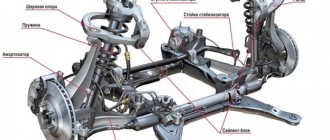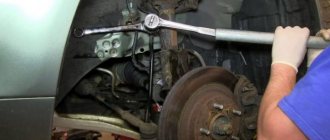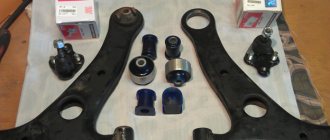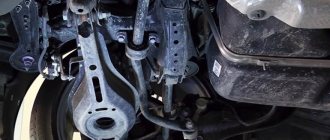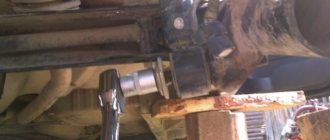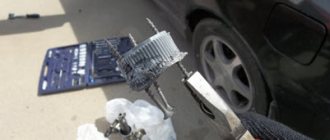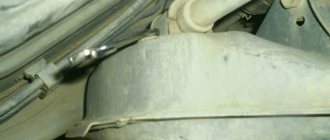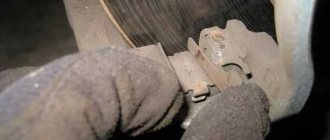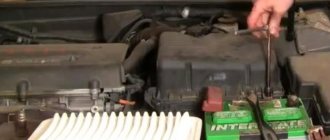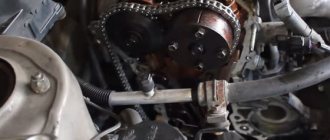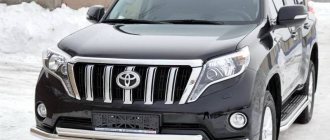The working life of silent blocks on cars is not eternal. This also applies to Japanese-made cars. When their resource is depleted, there is a need for their immediate replacement. In this article we will talk about how to replace light blocks on a Toyota Corolla.
To do this, we need to find out which model is on your car - old or new? It is important not to confuse them here, since they have different sizes - both in length and in width. When the type of part data is clarified, you can begin to search and purchase them. It is best to buy original silent blocks, since by buying a fake, you complicate your life - you will have to carry out the procedure for replacing them more often. Once the parts have arrived, you can immediately begin the replacement process.
Levers and silent blocks for Toyota Corolla 120
Compatibility of other manufacturers' products is not guaranteed. To avoid emergency situations, auto center technicians recommend purchasing only original products.
So that catalog items completely match the actual names. Carry out preventive maintenance strictly at designated time intervals in authorized workshops, where they provide a quality guarantee.
| Name | Article/OEM | Price, rub.) |
| Toyota Corolla rear suspension arm | Febest 0125-AE114R | from 980 |
| suspension arm | Japanparts BS291 | from 1300 |
| -/- rear | Japko 72291 | from 1300 |
| —/— front | Febest 0125-MCV20RH | from 1300 |
| -/- rear | Febest 0125-AE100R | from 1200 |
| —/— front | Febest 0125-141 | from 1200 |
| —/— rear Toyota Corolla | Toyota/Lexus/Daihatsu 4871012200 | from 1500 |
| —/— front | Herth+Buss J4912055 | from 1700 |
| —/— | Mapco 49570 | from 1800 |
| —/— front | Mapco 49571 | from 2000 |
| —/— front | Nipparts J4902004 | from 2100 |
| —/— front | Patron PS5135R | from 2100 |
| —/— Toyota Corolla | Blue Print ADT38652 | from 2100 |
| —/— Toyota Corolla | Blue Print ADT38651 | from 2400 |
| —/— front | Fenox CA11288 | from 2400 |
| -/- rear | Fenox CA11188 | from 2400 |
| -/- rear | Patron PS5135L | from 2400 |
| —/— Toyota Corolla | Monroe L13508 | from 2400 |
| —/— front | Monroe L13507 | from 2400 |
| —/— | NK 5014513 | from 2400 |
| —/— | NK 5014514 | from 2400 |
| Suspension arm left | Aywiparts AW1360467L | from 2500 |
| —/— right | Aywiparts AW1360468R | from 2500 |
| —/— Toyota Corolla | Japanparts BS-218L | from 2500 |
| —/— front | Febi 12932 | from 2500 |
| —/— Toyota Corolla | RTS 76-02530-2 | from 2500 |
| —/— front | Fenox CA11282 | from 2500 |
| -/- rear | RTS 76-02533-2 | from 2500 |
| —/— | RTS 76-02533-1 | from 2500 |
| —/— front | Febi 22949 | from 2500 |
This is interesting: Brake discs on the Lada Priora: selection and replacement
What to do if there is a knock?
The front suspension can knock for various reasons, but if you drive at high speeds (150 km/h and above), the knock is normal, and you should pay attention to it when it occurs at low speeds, when driving on relatively flat surfaces.
This problem can be solved quite simply. To do this, you need to tighten the bolt that secures the silent block: they unscrew due to shaking, so you can hear characteristic sounds on bumps. A knock in the rear suspension can occur for the same reasons.
A silent block that is not tightened properly may fail and will need to be replaced. You need to put the car on stands, remove the wheel, unscrew the bolt and two nuts securing the ball joint arm from below. To do this, you need to use heads 17 and 19. The bolt and nuts secure not only the part, but also the transverse rod of the suspension. You will have to pull out the lever, otherwise you won’t be able to get to the desired part. The most convenient way to do this is while under the car. If you have a pit or a lift, it will be much more convenient to work.
Tip: after you pull out the lever, you need to insert a pipe of the same diameter in its place.
After this, you can take a small hammer, with which you will need to knock the rubber part out of its place. After removing the silent block, the seat must be thoroughly cleaned, all dirt and traces of oil must be removed.
The inside of the new rubber will need to be lubricated before it can be installed in place. After this, the parts need to be assembled in reverse order. If a creaking or knocking noise appears in the front suspension, the rear suspension should also be checked, even if there is no creaking in it yet.
In order for the wear of consumables to be uniform and the load to be distributed correctly, silent blocks must be replaced in pairs.
This will not only ensure the suspension works correctly and eliminate extraneous sounds, but will also save time by not having to do the same job twice.
Rubber parts must be replaced in a timely manner. If you do this in advance, there will be no harm; you should not bring the condition of the silent blocks to critical. If they are worn out to the maximum and cannot perform their functions, the metal parts of the suspension will begin to rub against each other. This will lead to premature wear of the chassis and costly repairs.
About six months ago, the engine of this car was “rebuilt” in this car service. We replaced the piston and oil scraper rings, “caps”, installed eight new valves on the “exhaust” side, cleaned everything inside and after checking, gave the car to the Client. All. The work was done, everyone left happy with each other.
For a month or two, the Diagnostician’s phone was silent, but then the first call came from the Client, who, judging by his voice, was dissatisfied with something, but did not openly express his dissatisfaction, only his tone was... you know, there is such a tone of conversation called “Accusatory ":
— Hello...somehow my machine isn’t working well. - What exactly is “bad”? — You know, when starting up in the morning, you hear a sound from under the hood as if “valves are knocking.” You remember, I recently did some repairs... - And you think that the reason for this “knocking” is our reason, our fault? - No, not really, but you see... - Not a question. Pull up.
The question immediately arises: what does the Diagnostician and the “capital” of the engine have to do with it? The answer is simple: it was the Diagnostician who carried out the initial diagnostics and recommended that the Client carry out a “small update” of his engine. So that the engine can “breathe easier” and its parameters “more or less return to normal.”
Advised - means “Keep an answer!” Everything is correct, but not every Diagnostician will follow such urgent recommendations. To do this, you need to be very confident that you are right and understand what the consequences may be if his “diagnosis” turns out to be “not quite” correct. We will have to “respond with the ruble.” But the most important thing is to “respond with your reputation.” And it will be “more expensive” than any money...
This article will probably be read by both Diagnosticians and Clients. And what I would like to say... You know, let's all treat each other with Respect and Patience. Agree that the Diagnostician could completely refuse to look at this Client’s car again, if only because the “warranty time” had expired a long time ago. How long does the warranty last? Almost always and everywhere it is the same - thirty days. And only in exceptional cases this period can be extended. Yes, the Diagnostician could refuse to look at this car “repeatedly” without additional payment. This, by the way, is not such news; in many car services this is exactly what is done. Everything is correct, but now we are considering a case where the Diagnostician takes part in it. Didn't notice the difference? The word is written with a capital letter - Diagnostic. This means that he is not a “temporary worker”, not just a “diagnostician according to staffing,” he is a Diagnostician by Vocation. A rarity in our auto repair world, but it still exists and, I hope, will always be present.
In that, you know, “calm French manner,” the Diagnostician listened to the Client again and asked:
— What exactly do you propose? It’s clear from your conversation that you have some idea about cars... - I think the whole reason is that the valve clearance was initially installed incorrectly. The diagnostician shrugged: - Well, if you insist so, then let’s check everything again ...
In principle, this was not his, not Diagnostic’s, work. This is "mechanics". Moreover, “purely diagnostic” cars were waiting near the gate.
We started checking, photo 1 shows (top arrow No. 1) what we did first: we removed the valve cover and began measuring the gaps using feeler gauges.
photo 1
And what do you think? Everything is correct, the gaps were in perfect order. The diagnostician put the lid back and looked questioningly at the Client: “And what do we do now?” The client was a little confused... “Okay,” said the Diagnostician, “let’s try to find the real reason
your “fingers are knocking.” — Will it cost a lot? - And then you decide for yourself. I won't force you. We’ll find it - okay, we won’t find it... but this shouldn’t happen. Let's get started?
Indeed, there was a “knock” present. But it was an “interesting” knock: at times it disappeared, at times it intensified, and, what is most interesting, it was difficult to “catch it by ear” - if you bend down and listen from below, you get the impression that the sound is “coming” from the pan. If you “listen” from above, then the sound seems to “come” from under the valve cover. You can’t do without a medical phonendoscope here. (Everyone works differently here: some simply use a metal screwdriver to detect “sounds”, others use a thin wooden stick...).
The sound from under the timing belt cover seemed very “real” (photo 1, arrow 2). We removed it and carefully “listened” to both the first and second camshafts. Yes, there is “sound”, but it is somehow “muffled”. So, we must continue the search.
So we “went” to a “device” that we certainly couldn’t think of at the very beginning:
photo 2
Yes, yes, yes, don’t be surprised, this is it - the “check valve” at times made the same sounds, which at first glance could be mistaken for “clattering of valves.”
The simplest case, the simplest life story. It must be said that both the Client and the Diagnostician “passed through the malfunction” with dignity. Of course, a certain “nervousness” of the Client can be understood. He expressed it at the end with these words: “Sorry that this is the first time I’m so... a little nervous.” It’s just that previously I had to deal with such services, where they work and talk seemingly calmly and politely, but in the subtext you can always feel the unspoken “nah...”.
Let's be calm and polite. Neither impudence, nor “nervousness,” nor anything else that goes beyond the scope of “ordinary human communication” will add to us either peace or Health. But it will only harm the Cause. Right?
Vladimir Petrovich
Toyota repair and maintenance manuals
Car repair books
Originals and analogues
When repairing a car, it is important to purchase original or close to original parts. Some car owners prefer non-original suspension components: after all, they are considered “consumables”.
In some cases, it is better to purchase a similar part, since original components for the Corolla are quite expensive. This is due to the fact that this machine is guaranteed to wear out the levers quickly (they are considered a problem area). Replacing with similar parts will allow the car owner to save a certain amount of money.
So, the choice of components is large, so it’s worth visiting several showrooms (or checking several online stores) before purchasing directly. Let's take a look at how different suspension arms differ in price from different brands. The summary table shows the most popular replacement options:
| Manufacturer | vendor code | Price, rub.) |
| Allex | 3ZZ | 2900 |
| Sidem | 45277 | 3279 |
| Optimal | G61224 (1225) | 2606 |
| Febi | 21928 | 2811 |
For silent blocks the situation is similar. Original components are marked with article number 4347452030. Their price is quite low, so it is better to purchase silent blocks from the vehicle manufacturer. If they do not suit you in terms of quality or you just want to save a little, then pay attention to the following options:
| Manufacturer | vendor code | Price, rub.) |
| Avantech | ASB0190 | 1051 |
| FEBEST | TAB202 | 245 |
| Fulcrum | 106414 | 486 |
| Perfect | TO05ZE121WS | 161 |
Here the price spread is more noticeable than for levers for a similar car model. This is due to store markups and different quality of rubber inserts. It is advisable to purchase parts from trusted manufacturers: for example, from Point of Support. Of course, there are several dozen more different options, but prices will remain in the same range (from 160 to 900 rubles).
Front suspension maintenance
The Toyota Corolla has a MacPherson type front suspension. The high reliability of this design makes the machine quite popular all over the world, including in Russia.
In order to determine the technical condition of the front suspension on a Toyota Corolla, you should perform the following procedure:
- During maintenance, it is necessary to visually check protective covers, shock absorber struts, ball and rubber-to-metal joints, as well as bushings and rubber cushions for damage.
- The backlash of the joint (ball joint) should be determined. This can be done by manually swinging the lower lever vertically, then you should “hang” the vehicle wheel by the upper and lower parts around the longitudinal axis located horizontally.
- During a technical inspection, a leak in the shock absorber strut is usually detected, as well as scoring on the working rod surface, deformation and damage to other suspension parts.
- If signs of deformation are detected on them, the stabilizer bar and lower arms must be replaced.
- If the frame cross member, stabilizer bar and body front end are deformed, then the wheel angles change their parameters, making it impossible to adjust these parts. In order to avoid deformation of these parts, you should check the tightness of the bolts.
Part selection
Not original silent blocks.
The choice of silent blocks should be taken seriously, since the quality of the spare parts will determine how stable the suspension will be, as well as the softness of the levers. Many car enthusiasts replace original products with polyurethane analogues, which have a longer service life, but are much more expensive.
Original
48068-12300 – original catalog number of the rear silent block of the front suspension arm. The cost of the product is 3000 rubles.
Analogs
Due to the high cost of silent blocks of levers, many motorists are often looking for a lower quality and cheaper substitute. The automotive market offers a lot of different options.
| Manufacturer's name | Catalog number | Price |
| ABS | 270969 | 1000 |
| Akitaka | 0101-150B | 1000 |
| Amiwa | 02-35-1177 | 600 |
| Caster | FFD9321 | 700 |
| Febest | TAB-ACA30S | 600 |
| Fenox | CAB10013 | 600 |
| Gufu Parts | SRM-21105 | 600 |
| JD | JDT24ZE150B | 1000 |
| Jikiu | BH21118 | 700 |
| LYNXauto | C8572 | 800 |
| Nipparts | N4232056 | 1000 |
| Patron | PSE1428 | 700 |
| Sidem | 845638 | 600 |
| Stellox | 77-00438-SX | 800 |
| VAG | 357 407 182 | 400 |
| VAG | 1J0 407 181 | 1200 |
This is interesting: Wheels for Toyota Corolla 150: size, replacement of calipers and pads
Toyota Corolla E150 (2010+). Knocking and clicking noises when turning the car
Toyota Corolla E150 (2010+). Knocking and clicking noises when turning the car
| Possible causes of malfunction | Troubleshooting |
| Worn outer drive joint | Remove the drive and check the joint. If necessary, replace the hinge or drive assembly |
| Lack of lubrication in the joint | Inspect the case. Remove the drive and check the hinge. Apply sufficient new lubricant to the joint and replace the damaged joint cover. If there is play, replace the hinge or drive assembly |
| The intermediate bearing is severely worn | Remove the intermediate support bracket and check the play in the bearing. If necessary, replace the intermediate bearing |
Steering rod silent blocks can also cause clicking noises.
.
Wear of silent blocks and delamination of rubber can even produce clicks when turning the steering wheel in place and while driving. If this is the cause of the knocking, then the silent blocks must be replaced. If the steering wheel clicks when turning
, check the tie rod ends and tie rods. If the rack bushings are worn, a knocking sound may also appear in the steering wheel.
There is a small gap between the rack and gear. Sometimes it is possible to eliminate the gap using an adjusting bolt. If this does not help, then the worn bushings need to be replaced. The clicks may come from the steering column driveshaft. If damaged, it may make strange sounds. It just needs to be replaced. Clicks in the suspension when turning the steering wheel may indicate a breakdown of the outer CV joint. Then they will only appear when turning. If clicks occur when going uphill, then the inner CV joint is faulty. It is also easy to determine this breakdown: you need to drive the car onto an overpass and check the boots. If they do not fit well, the clamps are torn or have come off, then dirt has gotten inside the CV joint, and therefore it has failed. You should not delay the replacement, since over time the CV joint may completely turn out, then the car will need to be delivered to the repair site by tow truck or tow truck. The cause of clicks when turning may be a faulty CV joint.
If clicks when turning are heard along with the characteristic hum of the wheels, then the problem lies in the wheel bearing. One of the most dangerous malfunctions, it is better to immediately replace the bearings, and if the driver is forced to drive such a car, then the speed should not exceed 80 km/h.
COMMON CAUSES OF KNOCKING RELATED TO THE STEERING GEAR
Now let's look at typical problems and how to fix them. The first thing you need to do is check the pressure in the wheels, because the difference in tire inflation may be the cause of the knocking. Then check the fastening of the plastic protective fender liners. It is quite possible that the screws that secure them to the body have broken out, causing the fender liner to come off and cling to the wheel, making a knocking sound when turning.
In general, such a malfunction is very easy to fix; all you need to do is secure the torn fender liner with new screws. The most dangerous from a safety point of view is the appearance of a knock in the steering mechanism itself. To check the condition of the mechanism, you will need to drive the car onto an overpass. The first thing you need to check is the steering ends. Damage to the tip boot leads to sand getting inside it, which intensively wears out the surfaces of this element, causing play to appear in the tip, which is the source of knocking.
You can check the condition of the ends by loosening the tie rod with a pry bar. Strong play and knocking will indicate wear on the tip and the need to replace it. Steering ends for domestic cars are relatively inexpensive, and you can purchase them at almost any auto store. Replacing them is also easy. It is recommended to replace both tips at once. The complexity of performing this work comes down to the need to use a special puller.
After replacing the tips, you will still have to contact a service station to set the wheel alignment angles. A knock may also appear in the steering rod silent blocks. They are located in the place where these rods are attached to the steering rack.
Delamination of the rubber of these silent blocks can also lead to knocking, although it will appear not only when turning, but constantly while driving. This steering mechanism malfunction, although very rare, is still possible. It can be eliminated by removing the steering rods and pressing in new silent blocks. A knock may also appear in the steering mechanism itself. It usually forms after the rack guide bushings wear out, causing a gap to appear between the rack and gear. In some cases, everything can be eliminated by removing the gap with the mechanism's adjusting bolt. If this is no longer possible, you will need to remove the mechanism from the car, disassemble it and replace the worn guide bushings. A knock may even appear in the steering column universal joint. If for some reason it is damaged, it is quite possible that it is the cause of the appearance of third-party sounds. This problem is “treated” by replacing the cardan. You should also check the fastening of the mechanism body to the car body. Loose clamps may cause noise. This can all be eliminated by tightening the fastening nuts. Return to content
DRIVE AND SUSPENSION REASONS
Now let's move on to other elements of the car in which knocking may occur when turning the steering wheel. There are not many of them, but malfunctions with them can lead to expensive repairs. If you hear a knocking sound with a crunching effect when the wheel is turned completely, this often indicates severe wear of the constant velocity joint (CV joint) used in the wheel drive mechanism. The CV joint itself is a fairly reliable element if it is protected from dust and dirt getting inside. Read on the topic - replacing the inner CV joint boot of popular car models. Therefore, it is quite easy to determine that this is the cause of the knocking when turning - you need to carefully inspect the protective boot. If it is damaged, we can say with complete confidence that the cause of the third-party crunch is the CV joint. Many car enthusiasts claim that it is possible to fully restore the performance of the CV joint by removing it, washing it and adding new lubricant. Some additionally add small shavings of soft plastic to the lubricant, for example, from a cork from a Champagne bottle. Be sure to replace the damaged boot. However, such measures can only delay the replacement of the hinge for a while and in the end it will still have to be replaced. And when to perform this operation - immediately upon detection of damage to the boot, or a little later - it is up to the car enthusiast to decide. In many modern domestic cars, the weak point is the shock absorber strut bearing. It can also cause knocking. This problem seems to be easily solved - it is enough to replace the support, but sometimes this is not very easy to do. After all, you will have to remove the entire rack from the car. Also, a broken strut spring may be knocking in the suspension. At the same time, it will no longer be able to fully perform its functions, which will lead to rapid failure of the shock absorber. Therefore, if noise appears, you should immediately inspect the spring. If it bursts, you will have to change it, and it is changed in pairs on both sides of the car. If you hear a knocking sound on your car when turning, but it is also accompanied by a hum, it is likely that all this is due to wear on the wheel bearing. It is quite easy to diagnose his condition. You need to jack up the wheel on the side where the knock is coming from and rock it, checking for axial play. If such play exists, the bearing needs to be replaced, which is impossible to do without the appropriate equipment and knowledge.
ATYPICAL CAUSES
Often sounds may not appear due to the failure of any element; non-standard reasons also occur. For example, one car enthusiast experienced a knocking noise after a pebble flew onto the subframe and got stuck there. When the steering wheel was turned, the elements shifted, but they ran over this pebble, and when the steering wheel moved back, they jumped off it, making a knocking noise. Removing this stone eliminated the problem. For the second car enthusiast, after repairing the suspension, the replaced front arm hit the subframe when turning, which was accompanied by a knocking sound. This problem was “cured” by raising the subframe with a pry bar. These are somewhat unusual reasons for the appearance of knocking, but they have happened to car owners, so they should not be discounted. In general, often the cause of extraneous sound when turning the steering wheel can be identified by carefully inspecting the front of the car, as well as checking the fastening of certain elements. Return to content
PREVENTION OF KNOCKING
All of the above problems can arise not only with domestic cars, but also with expensive foreign cars. And the difference between these cars comes down only to the time after which the malfunction appears. Naturally, a foreign car will pass more without a malfunction than the same Priora. But repairing a foreign car, if, for example, its CV joint has failed, will cost much more. In most cases, knocking noises are caused by inadequate road surfaces. Moving over bumps and holes leads to the fact that all fasteners begin to weaken, hence the appearance of backlash. To prevent knocking noises when turning the steering wheel, periodic inspection of all elements is required. Moreover, this will require very little, and you can do everything yourself. The car is placed on an inspection hole or overpass, after which, while under it, you should carefully inspect all the elements, check the tightness of all fasteners with wrenches, tighten the nuts and bolts if necessary, swing the levers with a pry bar, checking for play. If you do all this periodically, you can avoid the occurrence of knocking noises, or at least increase the life of the car before they occur. Also, when traveling, you need to adhere to the speed limit, and pass difficult sections at low speed in order to slightly reduce the load on the elements of the suspension steering mechanism. And if in front of you unexpectedly there are depressions in the road surface, then slow down the car (the car will seem to nose down), and immediately before the problem section of the road, release the brake pedal. The front of the car will rise, thereby unloading the front suspension, and the car will coast over uneven roads without much damage to the chassis.
Useful video
To replace the silent blocks of the front levers on a Toyota Corolla, for convenience, you need to use a pit or a lift. And you should pay special attention to the choice of parts, since this will determine how long they will last.
Replacing silent blocks on a Toyota CorollaLink to main publication
Replacing levers and silent blocks on a Toyota Corolla 120
Signs of malfunction of car suspension components:
- car roll to one side;
- difficulty in controlling equipment at medium and high speeds;
- systematic knocking, beating, vibration in the steering wheel;
- tossing a car when overcoming road obstacles;
- metallic creak accompanying the control process.
The average service life of suspension elements is 60 – 85 thousand km. mileage Intervals exceeding the 100,000 mark are exceptions rather than practice. The manufacturing quality of spare parts and the driving style of the car are fundamental factors affecting the service life.
Before starting replacement work, we carry out comprehensive diagnostics, assess the general condition of the suspension elements, identify parts that require updating, and prepare consumables in the required quantity.
Replacement sequence:
- We install the car on the inspection channel, an electric lifting mechanism is possible;
- We place a hydraulic stand under the engine, since we will unscrew the support fastening to access the lever bolts on the right side;
- The service life of the suspension elements on the right and left sides is approximately equal. Experts recommend replacing two at the same time. Initially, unscrew the fastening of the ball joint of the left wheel, then two bolts and silent block fasteners;
- remove the lever from under the car;
- using a hydraulic press we press out one (two) silent blocks. As an analogue, use a stationary vice;
- If there are defects on the surface of the lever, there is damage to the metal or welds, the suspension element must be replaced with a new one. In all other cases, new silent blocks are pressed into the standard places;
- install the lever with new rubber bands in its original place;
- We begin dismantling the right element, having first lowered the engine support by 2 - 3 cm to provide access to the mounting bolt.
- We carry out a similar procedure for prevention, pressing in new rubber bands, and installing them in their original place.
During the work, we inspect the ball joint, brake cylinder, pads, and brake fluid supply lines. If there are signs of wear or deformation, the components must be replaced with new ones from stock. Eliminating small, sometimes insignificant faults will prevent large-scale breakdowns in the future. Thus, you can save money, time, effort, resources.
Subject to following the recommendations of the specialists, purchasing original spare parts, subsequent maintenance after 80,000 km. A moderate driving style will only increase the replacement interval for parts.
Parts that can knock in the front suspension
During the operation of a vehicle, various breakdowns may occur - this is a mechanism that requires periodic repairs and constant maintenance. Very often, motorists encounter knocking noises in the front suspension. It is impossible to say exactly from just the symptoms what the cause of the phenomenon is, but you can identify at least 7 details that can lead to this.
Stabilizer bushings . When these elements begin to knock, the sound may vary. Note that almost no master can determine the cause of the knocking by ear. This is done through diagnostics and examination. Stabilizer bushings, as a rule, are located on the frame, so the knock can be transmitted to the legs. Very often it is confused with torn silent blocks, but the knocking noise is much more common here. It is especially noticeable on small bumps. If the stabilizer bushings are bad, they cannot be diagnosed on a two post lift. You need to go to a pit or platform to load the wheels.
Stabilizer's pole . Among motorists they have a slightly different name “links”, from the English Link. The stabilizer is attached to both wheels, and it doesn’t matter here whether it’s on a strut or a lever. That is why, when driving over a bump, the knock will be transmitted to one side and the other. Diagnosing stabilizer bushings is not very difficult. It is necessary to carry out procedures on a pit or a lift. If you pull them, you can immediately hear the sound.
Steering rack . This problem affects vehicles that have traveled more than 150,000 km. Note that this does not necessarily apply to all cars, but the phenomenon cannot be ruled out. Diagnostics is carried out by hanging the wheel and rocking it. Very often this can be confused with a broken steering rack.
Tips, steering and silent blocks . All these parts make approximately the same knock. On medium and large bumps, in addition to knocking, you can hear a creaking sound. The silent blocks will hit your feet because the lever knocks on the underbody. Tips and balls should be diagnosed by rocking the hanging wheel. It's best to take a partner to help.
Calipers . Very often you can hear from motorists that they have changed everything, but knocking still occurs on small bumps. Then you need to pump the calipers. The guides begin to move in the established places, the knocking disappears if you press the brake pedal a little. Replacing the guides will not change anything, because the wear is in the caliper body. It needs to be drilled and larger controls installed.
Steering rods . This is the most complex part in the suspension. To determine a knock in the steering rod, you need to take an assistant who can reach the place where the ball enters the rod housing. In this area you need to press down the boot to feel the connection. Another person should rock the wheels at this time. If there is any play, it can be seen immediately.
Upper strut supports . The support bearing of the strut can be installed directly “in the crab”, or between it and the cup. And here a knock may appear for some reason. The sound can come from both the bearing itself and the inner sleeve that has come off.
Bottom line . A knock in the front suspension can occur for many reasons. There are 7 details that can lead to this.
Suspension functions
Suspension is the connecting link between the wheels and the main supporting system of the car - the frame and body. This unit provides a movable, not too rigid connection between the wheels and the body, in which they move up and down relative to the frame and body of the car. By ensuring vertical movement of the wheels, the suspension simultaneously limits their lateral and angular movements, which deteriorate the stability of the car. If it were not for the suspension, any shock from the contact of the wheels with the road would be fully transmitted to the body, and the car, instead of bouncing on bumps, would wobble left and right. The suspension solves the following problems:
- due to the connection of moving and fixed elements, it ensures vehicle movement, acceleration and braking, turning and lateral maneuvers;
- increases vehicle stability and improves handling, ensures a smooth ride, prevents skidding and rollovers;
- stabilizes the position of the car when turning;
- absorbs shock energy, protects body parts from premature wear and makes the ride more comfortable for the driver and passengers.
Is it possible to carry out repairs in the garage?
The service life of the Toyota Corolla suspension directly depends on the operating conditions of the vehicle. The more often you move on poor-quality road surfaces at high speed, the more likely it is that an unpleasant creaking, knocking, grinding noise will occur, indicating a malfunction in the car. You can get rid of these problems yourself, knowing the cause of the malfunction and having the necessary tools for repair at hand.
The suspension of the 2008 Toyota Corolla by now, as a rule, requires careful attention, since an almost ten-year-old car, even in very good conditions, begins to experience metal fatigue.
Cars of this generation are equipped with a relatively rigid, but ergonomic suspension that can absorb fairly noticeable impacts.
If you are the owner of a car produced in 2006–2008, you should not wait for a squeak to appear in the suspension. When the mileage approaches the 100 thousand km mark, it is necessary to carry out a routine check of the chassis in order to identify possible faults in advance and eliminate them. Such repairs will cost much less than those carried out on an emergency basis, when knocking or creaking will be clearly audible.
Which crosspiece to choose for Toyota Camry 40
If the steering shaft makes a knocking noise, the problem must be repaired as soon as possible. Otherwise, the accompanying elements will wear out, and the cost of fixing the problem will increase significantly. In case of excessive wear of the crosspiece, the owner has a choice:
- purchase a branded cross from an official dealer;
- buy a used stock from a car dismantling station;
- install a non-original crosspiece from a third-party manufacturer.
If the auto store does not have a crosspiece, you can order it online. Very often, replacement of crosspieces is required at the front and rear of the cardan, so it is recommended to purchase spare parts in a comprehensive package so as not to carry out repair work twice.
Catalog articles for silent blocks
| Name | Article/OEM | Price, rub.) |
| Rear axle silent block | FEBEST TAB166RUB | from 250 |
| Front arm silent block, front | FEBI 19009 | from 350 |
| Rear tie rod bushing | FEBEST TSB803 | from 350 |
| Suspension arm silent block | GSP 516723 | from 350 |
| C. rear link | FEBEST TABAE100CL | from 350 |
| —/— | GSP 510689 | from 350 |
| Bracket, lever cushions | Ashika GOM236 | from 450 |
| Silent block | RUVILLE 986901 | from 450 |
| —/— | FENOX CAB10023 | from 450 |
| —/— | KAVO PARTS SCR9007 | from 450 |
| —/— | FEBEST TAB010 | from 450 |
| —/— Toyota Corolla | YAMATO J42016AYMT | from 450 |
| —/— | FENOX CAB10055 | from 450 |
| -/- rear | FENOX CAB03018 | from 550 |
| —/— | Blue Print ADT38015 | from 550 |
| —/— | FENOX CAB02027 | from 550 |
| -/- rear | YAMATO J42014BYMT | from 550 |
| —/— | FEBEST TAB198 | from 550 |
| —/— | JAPANPARTS RU236 | from 550 |
| -/- rear | DELPHI TD372W | from 550 |
| —/— | JAPANPARTS RU2553 | from 550 |
| -/- rear | FENOX CAB20049 | from 550 |
| —/— | JAPANPARTS RU2454 | from 550 |
| —/— Toyota Corolla | FENOX FSB00040 | from 550 |
| —/— | Blue Print ADT38085 | from 550 |
| —/— | Ashika GOM2553 | from 550 |
| -/- rear | KAVO PARTS SCR9032 | from 550 |
| —/— | Nipparts J4232009 | from 550 |
| -/- rear | JAPANPARTS RU237 | from 550 |
| —/— | FEBEST TAB080 | from 550 |
| -/- rear | MAPCO 33561 | from 550 |
| —/— Toyota Corolla | JAPANPARTS RU267 | from 550 |
| —/— | Optimal F85286 | from 550 |
| —/— | SWAG 81929185 | from 550 |
| -/- rear | SIDEM 845647 | from 550 |
| —/— Toyota Corolla | MOOG TOSB7368 | from 550 |
| —/— Toyota Corolla | RUVILLE 986902 | from 550 |
